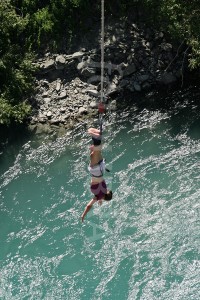When is twenty miles per hour freakin’ fast? When you’re strapped inside a harness and propel through the air across a zipline. Yes, that’s a picture of me a week ago. Can anyone scream, “Ahhhhh!”
Well, I didn’t. I wanted to, but once I stepped off the platform, it all became surreal, like watching a character from an adventure flick. I felt like Tarzan (or perhaps Jane?), although I was simply a business owner, leading a team of other would-be-adventurers.
You can learn much about leadership from ziplining. Here are some zippity-fast lessons:
Thinking about it is worse than doing it.
As one of my participants shared, thinking about it was the most challenging part about ziplining. Before we arrived at Snow Snake Mountain, we laughed about the potential dangers ahead, though we secretly carried around some level of anxiety. When I asked everyone how nervous they were on a scale of 1 to 10, all were at an 8 or higher. After the experience, however, we all agreed that perception was worse than reality. Ziplining was not only fun, but also easier than we had thought.
So leader, when you consider an upcoming project or idea, or when you contemplate some changes you might make, remember this: It’s probably not as difficult or scary as you imagine.
The first step off is always the hardest.
We zipped across ten lines. At each new line, we would step onto the platform and then hook our cable onto the line. Did I mention that the platform was teeny? Barely enough room for my feet to stand on? And did I mention that you can’t help but look down when standing on that platform? Thankfully, I don’t suffer from vertigo! But once on the platform, the only real next step was to jump off (that, or back out, hanging my head down like a dog, listening to the taunts of the group).
Similarly, when trying to accomplish a goal, the first step is often the hardest. Refusing to take that first step (because it’s the hardest) is what keeps us stuck. For example, I had a client who wanted to make a career change, but in a sea of choices, couldn’t bring herself to do anything. Rather, she preferred to analyze and re-hash every option available to her. Upon prodding, however, she finally decided to take the first step—setting up informational meetings with those whose careers most interested her. From there, everything careened along smoothly.
Baby-step it if you must.
When I saw the first of the ten lines we would zipline, I thought, “You’ve got to be kidding me. I’m paying for this? This is for babies.” It was a short line, no more than ten feet off the ground. By the time I got to the sixth line, when we were eighty feet off the ground, I thought, “You’ve got to be kidding me. I’m a big baby. Did I really pay for this?” Strategically, the instructor had us do the “baby-line” first as to increase our confidence.
Baby-stepping is a great way to build your self-confidence. Suppose you have a game-changing plan for your company or team. While big-picture-thinking is essential, it can also be paralyzing and overwhelming. So what’s a small, first step you can take? Too often we give up too soon (or never step off the platform to begin with) because we envision a monumental outcome—one that seems destined for failure. Break up that idea or project into small steps, and a successful outcome will be much more likely.
Your team is waiting on you.
Several participants of my passion, purpose, and legacy group coaching program accompanied me. If truth be told, I wasn’t sure about ziplining. Sure, it was on my bucket list, but I was nowhere near ready to kick the bucket!
When I stood on the platform to fly across the first line, I hesitated. (Okay, I hesitated on at least half of them.) I was under pressure. People were waiting in line for their turn. It was either jump or get pushed off the edge by thrill-seeking daredevils.
You have people, too, who are waiting for you to lead. So jump. If you don’t, they may push you aside so they can experience the thrill that awaits. And who can lead if there is no team?
So are you ready to leap?
Perhaps you need more convincing. Next week, read part 2 with four more zip-line leadership lessons. Until then, I’d love to hear your personal experiences in having applied some of the lessons above. You can put them in the box below.
